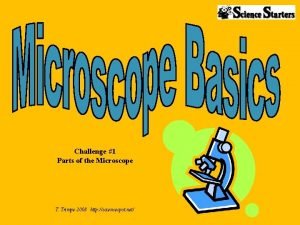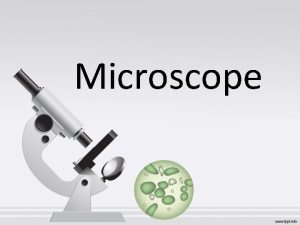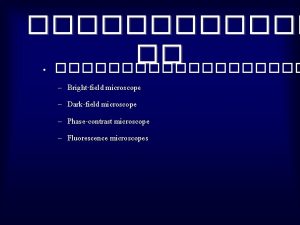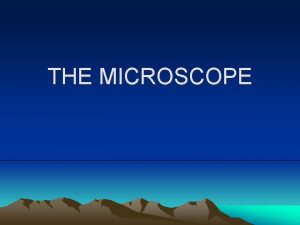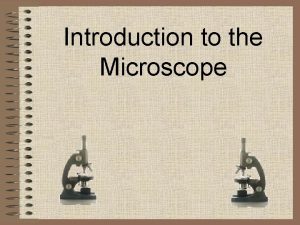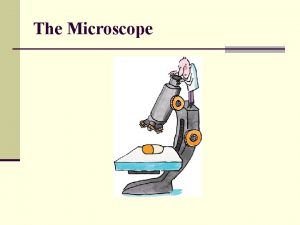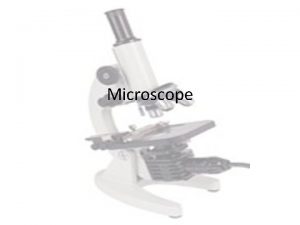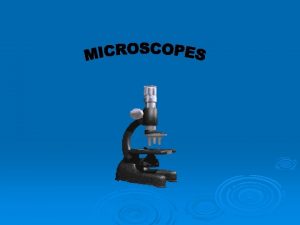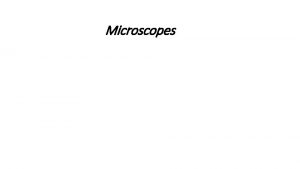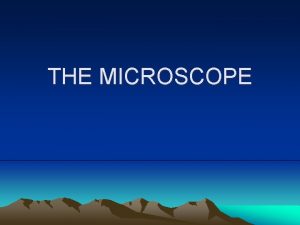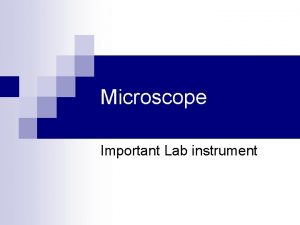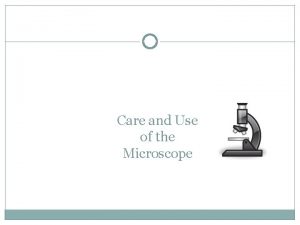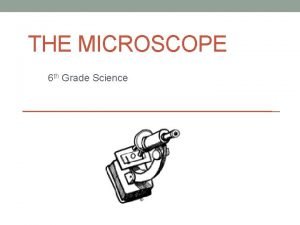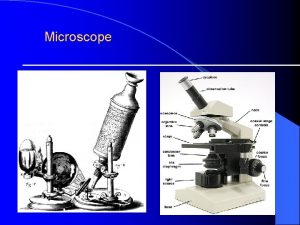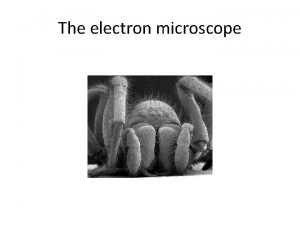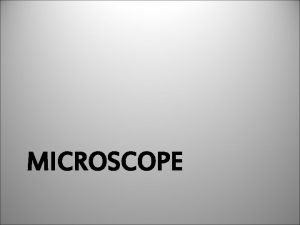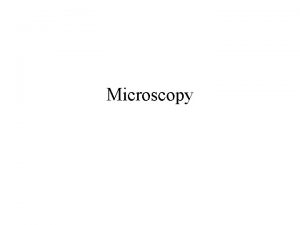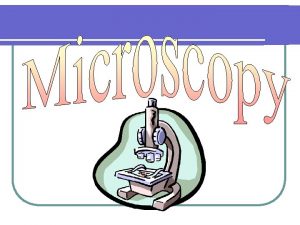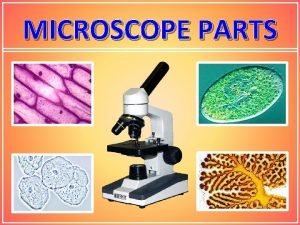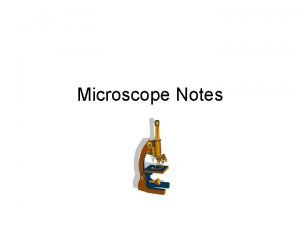The Microscope Why do we use a microscope






























- Slides: 30

The Microscope

Why do we use a microscope? • Many things are smaller than we can see with the naked eye. To accurately study Biology we need a tool to help us see these tiny things.


History • Antony van Leeuwenhoek is credited with developing the first microscope in about 1665. Although the compound microscope was already in use, what made Antony’s invention special was that he was able to magnify his ‘wee beasties’ by up to 270 X. • Antony was the first to see bacteria, red blood cells, yeast and so much more!


Types of Microscopes

Compound Light Microscope • Combines the power of lenses and light to enlarge the subject being viewed. • Typically, the eyepiece itself allows for 10 X or 15 X magnification and when combined with the three or four objective lenses, produce higher magnification to a maximum of around 1000 X generally. • The compound light microscope is popular among botanists for studying plant cells, in biology to view bacteria and parasites as well as a variety of human/animal cells.


Electron Microscopes • Objects smaller than 0. 2 um can be seen with an electron microscope. (Viruses, internal cellular structures)

Scanning Electron Microscope • Scanning Electron Microscope – Image appears in 3 -dimensions and in black and white. • The magnification is usually 1000 X to 10, 000 X. • It is particularly useful for studying the surfaces of cells and viruses.

Scanning Electron Microscope

Weevil, 75 X Mosquito head, 200 X

Red blood cells, color enhanced

Transmission Electron Microscope • The item to be viewed is sliced into very thin slices, the image is a slice of the cell. • These images are used to cross sections of cells and their intracellular structures. • Magnification can be as much as 10, 000 X to 100, 000 X.


Sperm cross section TEM, Mycobacterium tuberculosis TEM

STM: Scanning Tunneling Microscope • Used for looking at images on an atomic level • When a conducting tip is brought very near to the surface to be examined, a bias (voltage difference) applied between the two can allow electrons to tunnel through the vacuum between them


VENN DIAGRAM TIME!! • Compare and Contrast the 4 types of microscopes we have spoken about: • Compound Light • Scanning Electron • Transmission Electron • Scanning Tunneling • Write a small +/- next to each point.

More microscope resources • http: //www. microscopemaster. com/differenttypes-of-microscopes. html • http: //www. biologydiscussion. com/biology/5 important-types-of-microscopes-used-inbiology-with-diagram/2635 • http: //www. easybiologyclass. com/lightmicroscope-vs-electron-microscopesimilarities-differences-comparison-table/

Know the following Microscope parts and their function. • • Eyepiece Ocular lens Nosepiece Objective lens Stage clip Light switch Light intensity knob • • Fine adjustment Coarse adjustment Stage manipulator knobs Condenser Light source Iris diaphragm knob Cord holder Microscope body


Total Magnification • When the image travels through the objective lens and the ocular lens it magnifies the magnification of the objective lens by 10 X. Ocular lens Objective lens Total magnification 10 X Red 4 X 40 X 10 X Blue 10 X Yellow 40 X White 100 X 10 X 400 X 1000 X

The proper way to carry your microscope. • Always carry the microscope with two hands, holding it close to your body.

Improper carrying. • Carrying the microscope like this could result in your ruining a $1500. 00 piece of equipment. • This will not score you brownie points with your instructor!

Proper usage • At the lab table, unwrap only as much cord as you need, the rest should remain stored around the cord wrap.

• The microscope should always be stored with the 4 X (red) lens in place and the stage in its lowest position.

• Always store your microscope in its numbered position, with the dust cover in place.

How to focus your image • Place the slide on the stage, held in place by the stage clip. • ALWAYS start with the 4 X lens. Focus your image. • Move to the 10 X lens, focus. • NEVER use the coarse focus higher than 4 X. • Repeat at the 40 X lens, focus using the fine focus.

Distance between lens and slide • Use only the fine focus knob with the 40 X and 100 X lens.
 Pictures
Pictures Don't ask why why why
Don't ask why why why Difference between light microscope and electron microscope
Difference between light microscope and electron microscope Microscope mania compound light microscope
Microscope mania compound light microscope Hình ảnh bộ gõ cơ thể búng tay
Hình ảnh bộ gõ cơ thể búng tay Ng-html
Ng-html Bổ thể
Bổ thể Tỉ lệ cơ thể trẻ em
Tỉ lệ cơ thể trẻ em Chó sói
Chó sói Chụp phim tư thế worms-breton
Chụp phim tư thế worms-breton Hát lên người ơi
Hát lên người ơi Môn thể thao bắt đầu bằng chữ đua
Môn thể thao bắt đầu bằng chữ đua Thế nào là hệ số cao nhất
Thế nào là hệ số cao nhất Các châu lục và đại dương trên thế giới
Các châu lục và đại dương trên thế giới Công của trọng lực
Công của trọng lực Trời xanh đây là của chúng ta thể thơ
Trời xanh đây là của chúng ta thể thơ Mật thư tọa độ 5x5
Mật thư tọa độ 5x5 101012 bằng
101012 bằng độ dài liên kết
độ dài liên kết Các châu lục và đại dương trên thế giới
Các châu lục và đại dương trên thế giới Thể thơ truyền thống
Thể thơ truyền thống Quá trình desamine hóa có thể tạo ra
Quá trình desamine hóa có thể tạo ra Một số thể thơ truyền thống
Một số thể thơ truyền thống Cái miệng bé xinh thế chỉ nói điều hay thôi
Cái miệng bé xinh thế chỉ nói điều hay thôi Vẽ hình chiếu vuông góc của vật thể sau
Vẽ hình chiếu vuông góc của vật thể sau Biện pháp chống mỏi cơ
Biện pháp chống mỏi cơ đặc điểm cơ thể của người tối cổ
đặc điểm cơ thể của người tối cổ V cc cc
V cc cc Vẽ hình chiếu đứng bằng cạnh của vật thể
Vẽ hình chiếu đứng bằng cạnh của vật thể Fecboak
Fecboak Thẻ vin
Thẻ vin



